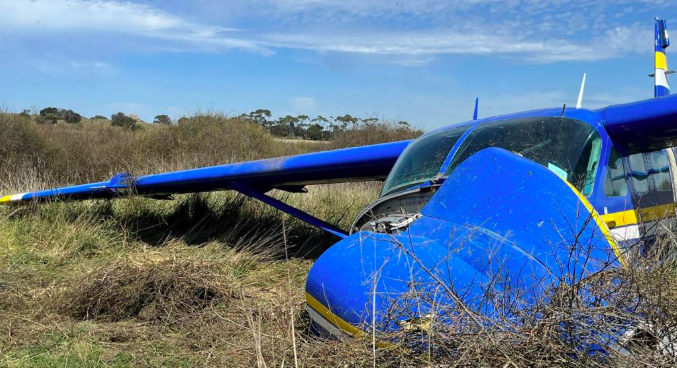Lessons Learned: The Importance of Providing Essential Safety Actions

The wake of an accident involving 15 injuries spurred agency commitment to a range of safety actions.
A skydiving aircraft operator, the Civil Aviation Safety Authority, and the Australian Parachuting Federation have committed to a range of safety actions in the wake of an accident in which 15 people were injured.
On October 20, 2023, a modified Cessna 208 Caravan took off from Barwon Heads Airport, Victoria, for a planned skydiving jump from 15,000 ft. On board were the pilot and 16 parachutists.
Passing about 500 ft on climb, the pilot detected a partial power loss, which they considered consistent with a transient activation of the aircraft’s torque and temperature limiter, encountered on the aircraft previously.
Expecting power to return immediately, as it had in past instances, the pilot did not lower the aircraft’s nose to maintain airspeed, and instead reduced thrust slightly, to prevent the engine surging when power was restored.
“As a result, airspeed continued to reduce until the stall warning horn sounded,” ATSB Chief Commissioner Angus Mitchell explained.
Low height, low power, low airspeed
“Due to the low height, low power, and low airspeed, the pilot searched for a suitable location for a forced landing, selecting a clearing beyond the Barwon River.
“Less than a minute after becoming airborne, the aircraft impacted the water short of the clearing, resulting in water entering the cabin.”
The aircraft continued onto the riverbank, where the main landing gear detached. The aircraft then traveled along the ground for about 50 m before coming to rest.
Six of the parachutists sustained serious injuries, and the pilot and eight parachutists sustained minor injuries in the accident. The aircraft was substantially damaged.
The ATSB’s investigation found the partial loss of engine power was likely due to an abnormal activation of the TTL, as identified by the pilot.
However, it notes the operator, Experience Co’s engine power loss checklist instructed pilots to significantly reduce power in preparation for deactivating the TTL, but did not specify a minimum safe height at which to do so, increasing the risk of a loss of control at low altitude.
The investigation also identified a number of issues associated with the loading of the aircraft and its conversion and use for parachuting operations, although these were not found to have contributed to the accident.
“The software used to calculate weight and balance did not provide a warning if individual zones were overloaded, and the operator’s weight and balance calculation for the accident flight was inaccurate,” Mr. Mitchell explained.
The investigation also identified Experience Co did not ensure parachutists received essential safety information about emergency exits, restraints and brace position, prior to takeoff.
“While parachutists accept some risk associated with their sport, this does not mean they should be exposed to additional risk in the operation of parachute drop flights,” Mr. Mitchell said.
“To maximize survivability in the event of an emergency, pilots are required to ensure aircraft occupants receive a safety briefing and instructions, including in the correct use of restraints, emergency exits, and adopting the brace position.”
Experience Co has subsequently taken safety action to address weight and balance issues, and has made an annual requirement for sport skydivers to take part in briefings covering essential safety information.
While not identified as a safety factor in this safety actions investigation, the ATSB’s final report also notes the accident aircraft had been converted to carry up to 17 parachutists, and the operator routinely conducted such parachuting operations based on the CASA-accepted Australian Parachute Federation Jump Pilot Manual.
However, the aircraft’s amended configuration for this purpose was not formally documented in the aircraft flight manual or a supplement.
“Under CASA guidance, increasing the number of people carried above that stated on an aircraft’s type certificate data sheet requires a supplemental type certificate (STC),” Mr. Mitchell explained.
During an STC application made by the design engineer in 2017, CASA questioned the potential impact on emergency egress of the increased number of passengers enabled by the modifications, but this application was never finalized.
“Although the parachuting configuration was assessed as compliant with the required airworthiness standards, parachutists were exposed to greater risk of harm than if they were passengers in certified seats with adequate restraints,” Mr. Mitchell said.
“Those seated on the floor did not have the benefit of a seat to absorb impact forces and the bench seating had not been shown to optimally absorb impact forces.”
In response to this accident, the Australian Parachuting Federation examined aircraft flight manual wording across its members’ fleets, and found 22 aircraft, across 5 operators, capable of carrying more passengers than could normally be carried under normal seating configurations.
Exemption in production, slated for mid-2025
CASA subsequently told the ATSB an exemption is being developed for such aircraft, expected to be completed by mid-2025. In the interim, CASA said it was satisfied reasonable safety actions steps have been taken by the Parachuting Federation to ensure a level of safety commensurate with the risks involved in parachuting.
Content/image credit: ATSB (Australian Transport Safety Bureau), “Barwon Heads parachuting aircraft accident highlights the importance of providing essential safety information,” published 3/14/2025.
Read the final report: “Partial power loss and collision with terrain involving Cessna 208, VH-UMV, near Barwon Heads Airport, Victoria on 20 October 2023.” Publication date: 3/14/2025.



